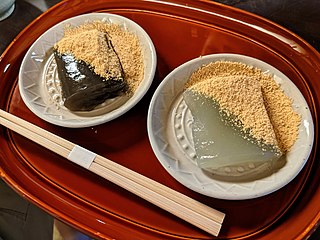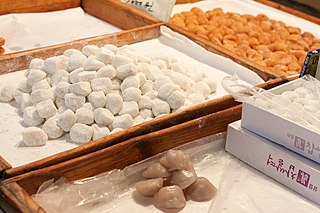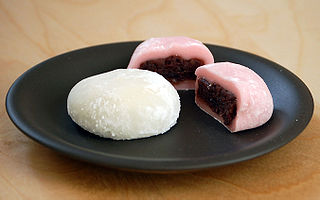Mochi is a Japanese rice cake made of glutinous rice pounded into paste and molded into shape.
Contents
Mochi may also refer to:
Mochi is a Japanese rice cake made of glutinous rice pounded into paste and molded into shape.
Mochi may also refer to:

A doughnut or donut is a type of food made from leavened fried dough. It is popular in many countries and is prepared in various forms as a sweet snack that can be homemade or purchased in bakeries, supermarkets, food stalls, and franchised specialty vendors. Doughnut is the traditional spelling, while donut is the simplified version; the terms are used interchangeably.

Mochi is a Japanese rice cake made of mochigome (もち米), a short-grain japonica glutinous rice, and sometimes other ingredients such as water, sugar, and cornstarch. The rice is pounded into paste and molded into the desired shape. In Japan, it is traditionally made in a ceremony called mochitsuki. While eaten year-round, mochi is a traditional food for the Japanese New Year, and is commonly sold and eaten during that time.

Glutinous rice is a type of rice grown mainly in Southeast and East Asia, and the northeastern regions of South Asia, which has opaque grains, very low amylose content, and is especially sticky when cooked. It is widely consumed across Asia.

Nian gao, sometimes translated as year cake or New Year cake or Chinese New Year's cake, is a food prepared from glutinous rice flour and consumed in Chinese cuisine. It is also simply known as "rice cake". While it can be eaten all year round, traditionally it is most popular during the Chinese New Year. It is considered good luck to eat nian gao during this time of the year because nian gao (年糕) is a homonym for "higher year" or "grow every year" (年高), which means "a more prosperous year". The character 年 is literally translated as "year", and the character 糕 (gāo) is literally translated as "cake" and is identical in sound to the character 高, meaning "tall" or "high". Nian gao (年糕) also is an exact homonym of "sticky cake" (粘糕), the character 粘 (nián) meaning "sticky".

A rice cake may be any kind of food item made from rice that has been shaped, condensed, or otherwise combined into a single object. A wide variety of rice cakes exist in many different cultures in which rice is eaten and are particularly prevalent in Japan. Common variations include cakes made with rice flour, those made from ground rice, and those made from whole grains of rice compressed together or combined with some other binding substance.

Tangyuan is a traditional Chinese dessert made of glutinous rice shaped into a ball that is served in a hot broth or syrup. They come in varying sizes, anything between a marble to a ping pong ball, and are sometimes stuffed with filling. Tangyuan is traditionally eaten during the Lantern Festival, but because its name is a homophone for union and symbolizes togetherness and completeness, this dish is also served at weddings, family reunions, Chinese New Year, and the Dōngzhì festival.

Mochi ice cream is a confection made from Japanese mochi with an ice cream filling. It was invented by Japanese-American businesswoman and community activist Frances Hashimoto.

Rice flour is a form of flour made from finely milled rice. It is distinct from rice starch, which is usually produced by steeping rice in lye. Rice flour is a common substitute for wheat flour. It is also used as a thickening agent in recipes that are refrigerated or frozen since it inhibits liquid separation.

Warabimochi is a wagashi made from warabiko and covered or dipped in kinako. It differs from true mochi made from glutinous rice. It is popular in the summertime, especially in the Kansai region and Okinawa, and often sold from trucks, similar to an ice cream truck in Western countries.

Chapssal-tteok, also called chaltteok, is a tteok, or Korean rice cake, made of glutinous rice.

Ciba, also known as nianba, is a traditional Chinese snack made by glutinous rice pounded into paste. It is often molded into shapes of balls or cuboids. Ciba is often fried or steamed before being served.

Bua loi or bua loy is a Thai dessert. It consists of rice flour rolled into small balls, and cooked in coconut milk and sugar. Some Bua loi also adds sweet egg into the recipe. It was inspired by Tangyuan, a Chinese dessert that is traditionally eaten around the Lantern festival. Bua Loi also traditionally eats at the Dongzhi Festival in Thailand, which is festival for the Chinese-Thai bloodline. There are a variety of versions of Bua loi such as using food coloring instead of natural color, using soy milk instead of Coconut cream, sliced Pumpkin to add inside rice balls, et cetera. There's other type of Bua loi in other country from China, Japan, Indonesia, Myanmar, Philippines, and Southern Vietnam. 1 cup of Bua Loy has total calories of 295.5 kilocalories, protein of 10.4 grams, carbohydrate of 6.3 grams, and fat of 25 grams.

Daifukumochi (大福餅), or daifuku (大福), is a wagashi, consisting of a small round mochi stuffed with a sweet filling, most commonly anko,. Daifuku is a popular wagashi in Japan and is often served with green tea.

Puto bumbong is a Filipino purple rice cake steamed in bamboo tubes. It is traditionally sold during the Christmas season. It is a type of puto.

In the Burmese language, the term mont translates to "snack", and refers to a wide variety of prepared foods, ranging from sweet desserts to savory food items that may be cooked by steaming, baking, frying, deep-frying, or boiling. Foods made from wheat or rice flour are generally called mont, but the term may also refer to certain varieties of noodle dishes, such as mohinga. Burmese mont are typically eaten with tea during breakfast or afternoon tea time.

Zunda-mochi (ずんだ餅) is type of Japanese confectionary popular in northeastern Japan. It is sometimes translated as "green soybean rice cake." It generally consists of a round cake of short-grained glutinous rice with sweetened mashed soybean paste on top. In some varieties, the green soybean paste entirely covers the white rice cake. In all cases, immature soybeans known as edamame are used. A closely related product is "kurumi-mochi", which uses walnuts instead of soybeans.

Mochi donuts, also known as poi mochi, are a fusion pastry crossing traditional American doughnuts and Japanese mochi. The mochi donuts' "hybrid batter makes for a doughnut that is fluffy and moist, with a satisfying chew". An early iteration can be traced to Hawaii in the early 1990s, however, the mochi donut was popularized by Mister Donut's "Pon de Ring" iteration in the early 2000s. Mochi donuts are now most commonly shaped into eight small balls connected into a circular shape that is easy to pull apart and are made out of glutinous rice flour or tapioca flour.

Butter mochi is a cake made from coconut milk, glutinous rice flour, and butter and is a popular dessert in Hawaiian cuisine.